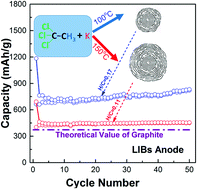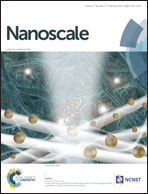The effect of hydrogenation on the growth of carbon nanospheres and their performance as anode materials for rechargeable lithium-ion batteries
Abstract
Hydrogenated carbon nanomaterials exhibit many advantages in both mechanical and electrochemical properties, and thus have a wide range of potential applications. However, methods to control the hydrogenation and the effect of hydrogenation on the microstructure and properties of the produced nanomaterials have rarely been studied. Here we report the synthesis of hydrogenated carbon nanospheres (HCNSs) with different degrees of hydrogenation by a facile solvothermal method, in which C2H3Cl3/C2H4Cl2 was used as the carbon precursor and potassium as the reductant. The hydrogenation level of the obtained nanospheres depends on the reaction temperature and higher temperature leads to lower hydrogenation due to the fact that the breaking of C–H bonds requires more external energy. The reaction temperature also affects the diameter of the HCNSs and larger spheres are produced at higher temperatures. More importantly, the size and the degree of hydrogenation are both critical factors for determining the electrochemical properties of the HCNSs. The nanospheres synthesized at 100 °C have a smaller size and a higher hydrogenation degree and show a capacity of 821 mA h g−1 after 50 cycles, which is significantly higher than that of the HCNSs produced at 150 °C (450 mA h g−1). Our study opens a possible way for obtaining high-performance anode materials for rechargeable lithium-ion batteries.


 Please wait while we load your content...
Please wait while we load your content...